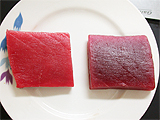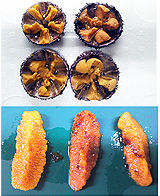Studies of the freezing in aquatic products
 Frozen fish block:
Frozen fish block:
Left: fresh tuna(unfrozen)
Right: frozen and stored tuna for
9 days at -5 degrees C
|
Mechanism of color changes in frozen lean meat.
How to evaluate the quality of lean meats such as tuna and beef does?
The brightness of red color of meats is one of the most important characters.
When the color of them is changed to brown, a willingness to buy of customers would be decreased.
This color change is caused by an oxidation, myoglobin to metmyoglobin, and which is an irreversible process.
We revealed that the speed of the deterioration in the freezing storage around -5 degrees C is faster than in -18 dgrees C.
Making clear the mechanism of the acceleration of the oxidation by freezing around -5 dgrees C, we aim to establish the best preservation method of meats.
In addition, we develop a computer simulation of this process and make a visualization of food quality changes.
|
|
|
Development of the best thawing methods of frozen small fishes
Frozen foods have mainly three processes, freezing, storage, and thawing.
If you make at least the one of them failed, the quality of them will get to be notably bad.
In this study, we focus our interests on thawing process.
From controlling the thawing speed and thawing temperature, we found the best thawing method suitable for small fishes is to keep the surface temperature of 0-4degree C during thawing.
|
 Dripping of tuna
Dripping of tuna
|
MMechanism of drip loss from thawed tissue of foods.
When frozen foods are thawed, a liquid component lost as so called drip.
The drip is one kind of evaluation of tissue damage by freezing.
Since there are many measurement methods, amounts of drip are different among ways.
We investigates the relationships between the amount of drip and a denaturation of proteins in tissue to find the best measurement method for drips and tissue damage.
|
 Freezing experiment of sea urchin(UNI)
Freezing experiment of sea urchin(UNI)
|
The freezing method of sea urchin eggs(UNI)
(Cooperative research with Nemuro city, Japan)
It is too fast deterioration too hard to keep freshness of "uni".
Consumers in Japan want to eat raw, however, most of them processed to preserve several treatments such as heated, pressured, or pickled with salt.
If the best freezing and thawing methods on the sea urchin eggs is developed, the distributions for long distance or eat any time throughout the year will be possible.
|
|

